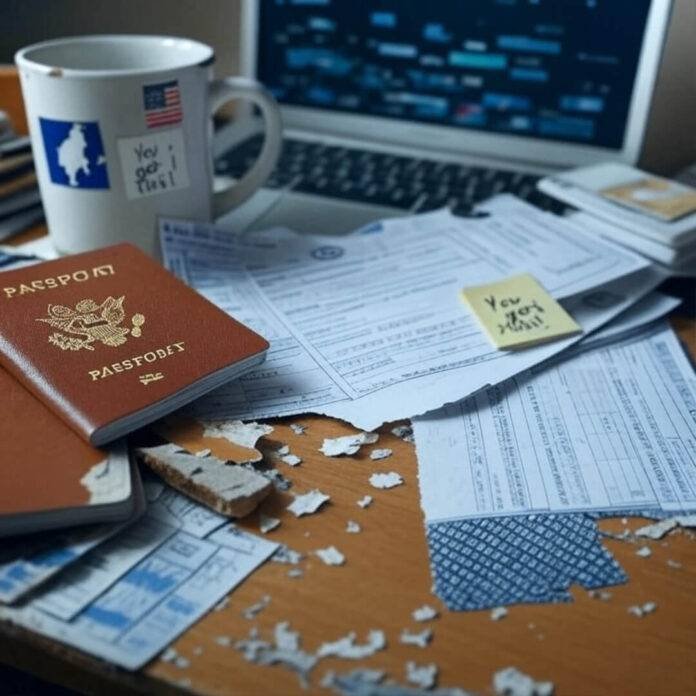The U.S. work visa process is a straight-up circus, y’all. I’m sitting here in my tiny Bronx apartment, surrounded by takeout bags and a desk that looks like a paper shredder exploded. My H-1B journey last year was a hot mess—spilled coffee on my forms, lost my passport for a solid week, the whole deal. I’m no lawyer, just a dude who stumbled through the U.S. work visa process and somehow made it. Here’s my raw, unpolished take for 2025, with all my dumb mistakes and some tips I wish I’d known. Buckle up; it’s messy.
Why the U.S. Work Visa Process Feels Like a Fever Dream
Real talk: the U.S. work visa process is like signing up for a reality show where the prize is stress. I was pacing outside the consulate in a drizzle, my hoodie soaked, freaking out because I forgot my job offer letter. Had to text my boss to email it, like, now. You have to figure out which visa fits—H-1B for tech or fancy jobs, L-1 for company transfers, or O-1 if you’re some kind of superstar (spoiler: I’m not). The USCIS website has the official breakdown on visas—dry as toast, but it’s the starting line.
- H-1B: For “specialty” jobs like coding. It’s a lottery, so cross your fingers.
- L-1: If you’re moving to a U.S. branch of your company. Less random, still a slog.
- O-1: For legit geniuses. I thought my Etsy shop counted. Nope.
I almost tanked this step, thinking my marketing gig was H-1B gold. Turns out, my communications degree was a stretch. Cue me stress-eating pretzels at 2 a.m.
Step 1: Figuring Out If You Even Qualify for the U.S. Work Visa Process
First thing, you have to know if you’re eligible for the U.S. work visa process. I was all, “Psh, I got this,” until my HR lady pointed out my degree didn’t match my job description. Major facepalm. You need a U.S. employer to sponsor you, and your role has to fit the visa rules. H-1B usually requires a bachelor’s degree or equivalent experience. I spent nights Googling “H-1B eligibility” while munching stale chips, wondering if my freelance gigs counted. They did, but proving it was a nightmare.
Pro tip: Talk to your employer early. Mine was cool but clueless, so we fumbled together. Also, don’t be me—make sure your degree lines up with your job.

Step 2: The Paperwork Hell of the Work Visa Application
The paperwork for the U.S. work visa process is insane. Forms like I-129, DS-160, and a million random docs—passports, job letters, and transcripts. I lost my birth certificate for a hot minute and found it in a drawer with old Pokémon cards. Yeah, I’m that guy. The U.S. Department of State has a checklist that saved my bacon—bookmark it, for real.
- Form I-129: Your boss files this with USCIS. You just have to send them your life story.
- DS-160: Online visa app. Save the confirmation number, or you’re toast.
- Supporting Docs: Degrees, work history, and translations for non-English stuff.
Biggest screw-up? I spelled my own name wrong on the DS-160 because I was rushing. Had to redo it and felt like a total doofus. Check your stuff, like, three times.
Step 3: The U.S. Work Visa Interview (AKA Panic Mode)
The visa interview is where the U.S. work visa process gets real. I was a sweaty disaster outside the embassy, clutching a soggy folder, my hoodie half-drenched. Inside, it’s like a DMV but scarier—all fluorescent lights and stern faces. The officer asked about my job, my qualifications, and why I wanted to work in the U.S. I rambled about NYC’s bagels, which got a laugh but didn’t help. Prep with sample questions from Boundless—it’s a game-changer.

Step 4: Waiting (and Losing My Mind) in the U.S. Work Visa Process
The wait after the interview is torture. I was checking CEAC like a maniac, refreshing every hour while stress-eating bodega tacos. It took eight weeks for my approval, and when it came, I tripped over a pizza box doing a victory dance. If you get approved, your visa gets stamped in your passport. If not, don’t freak—talk to a lawyer. I almost needed one when my app got held up over a missing transcript.
My Big, Messy Lessons from the U.S. Work Visa Process
Look, the U.S. work visa process beat me up, and I made every mistake possible. I underestimated the timeline, lost papers, and stressed so hard I forgot how to blink. But I learned to stay semi-organized, bug my employer for help, and laugh at my dumb self. Like, when my visa finally came through, I blasted “Sweet Caroline” and knocked over a lamp dancing. Classic me.
- Start early—like, six months early, no joke.
- Check your forms like you’re defusing a bomb.
- Find a crew. I lurked on r/immigration, and it kept me from losing it.

Wrapping Up My U.S. Work Visa Process Rant
So, that’s my sloppy, real-deal guide to the U.S. work visa process. I’m in the Bronx now, sipping overpriced seltzer, thankful I made it. It’s a grind, but you got this—just don’t lose your birth certificate in a Pokémon card stash like me. Got your own visa horror stories? Drop ‘em in the comments or check out r/immigration for some solidarity. Keep pushing, fam!




